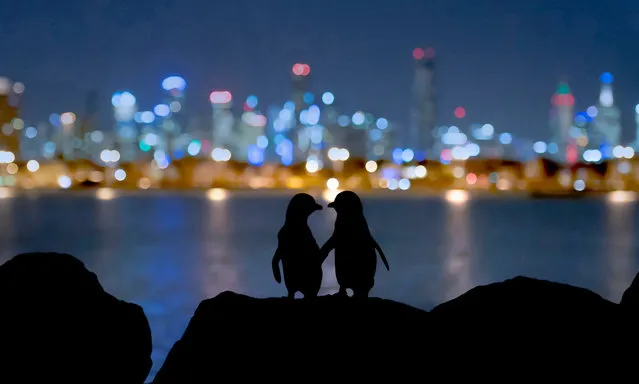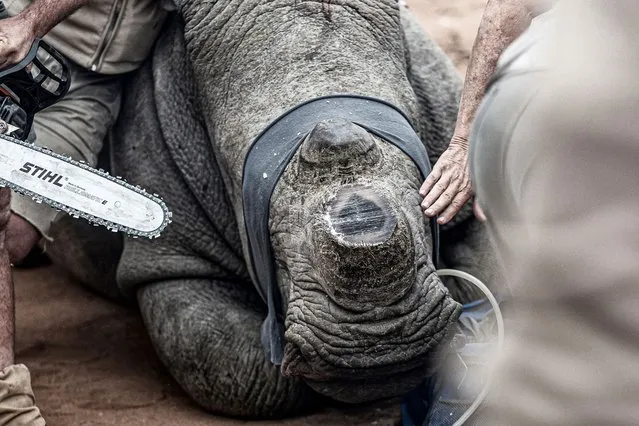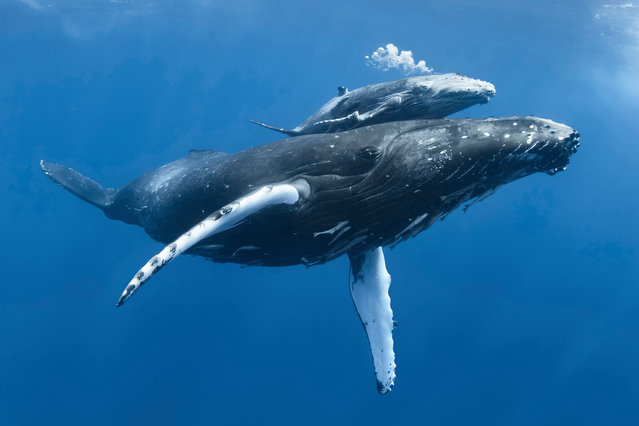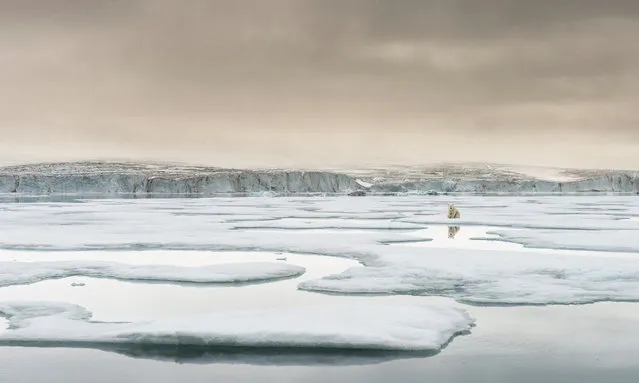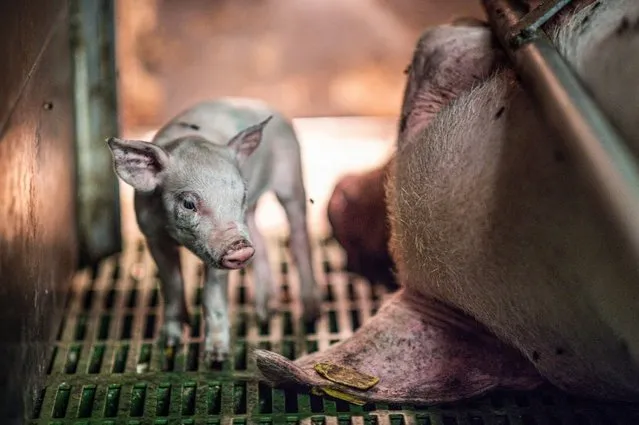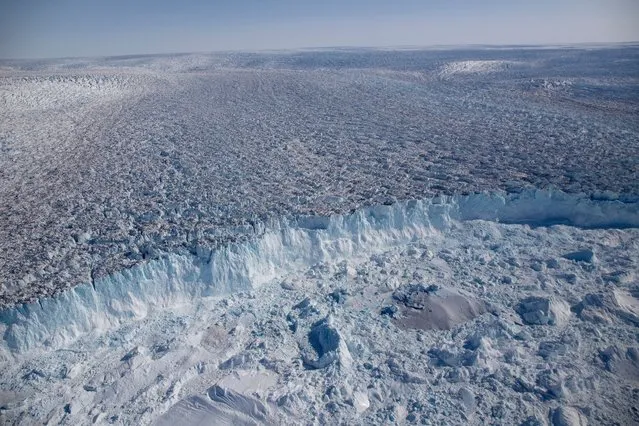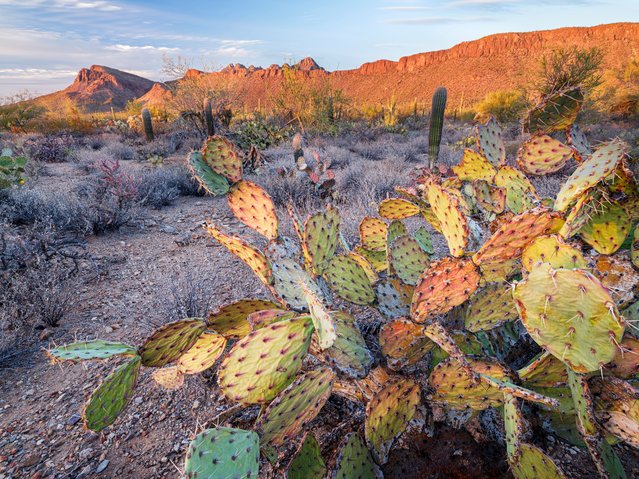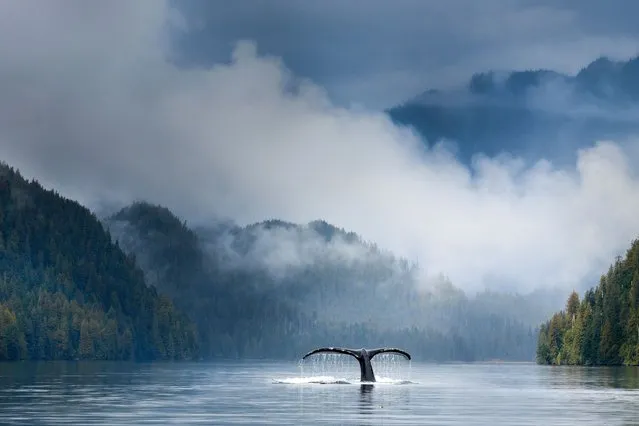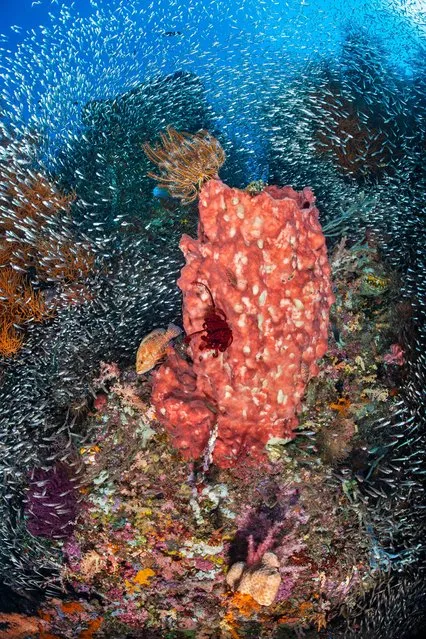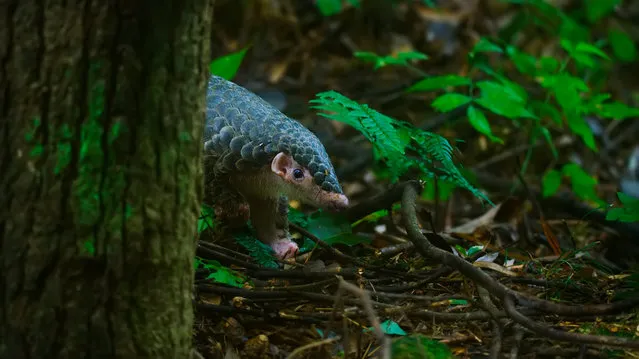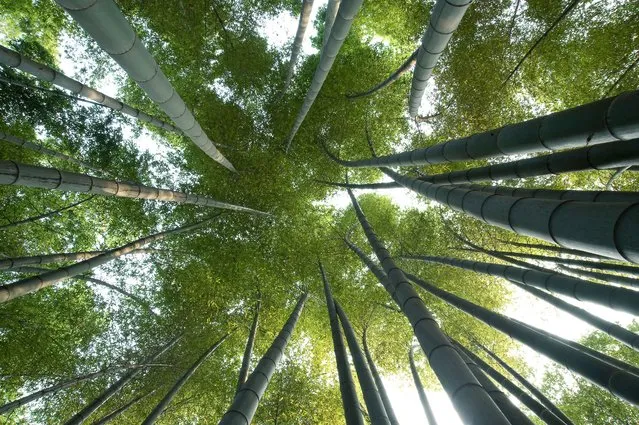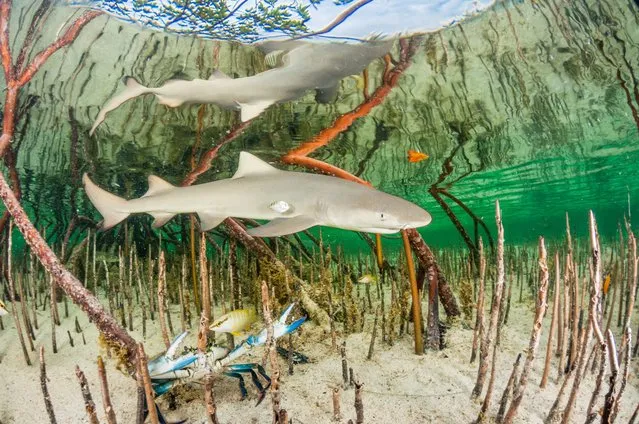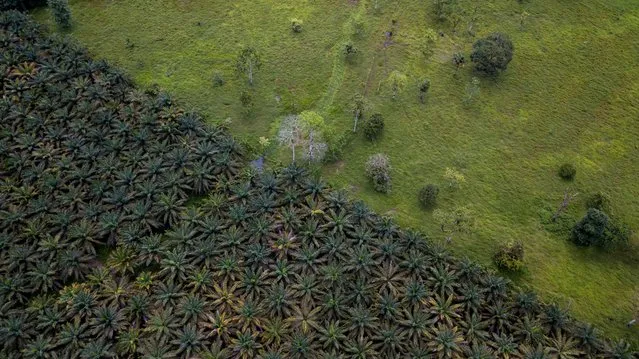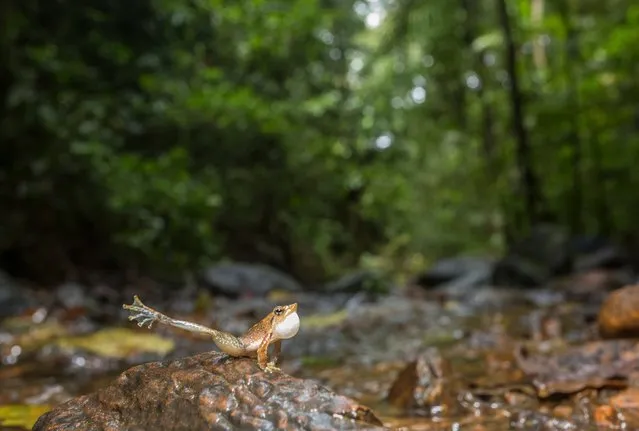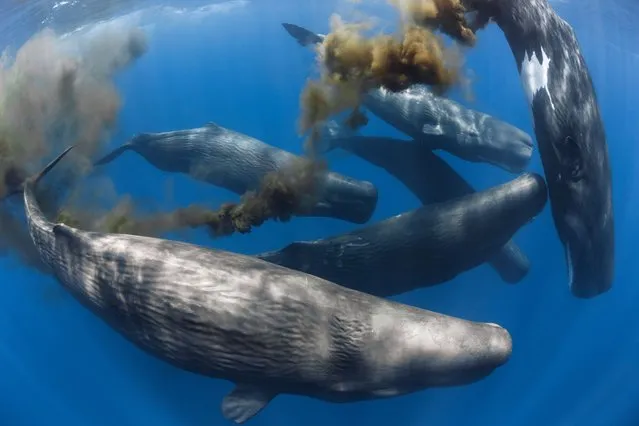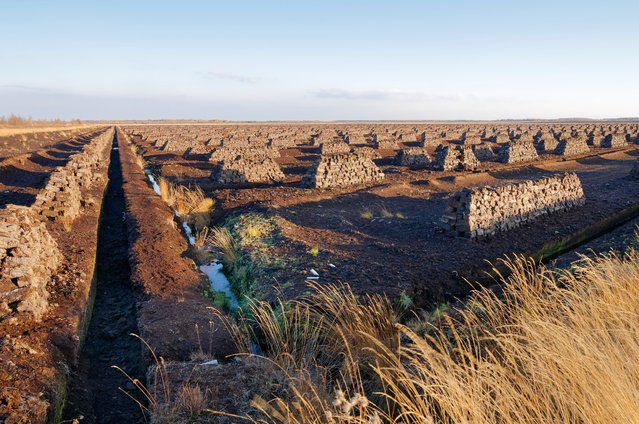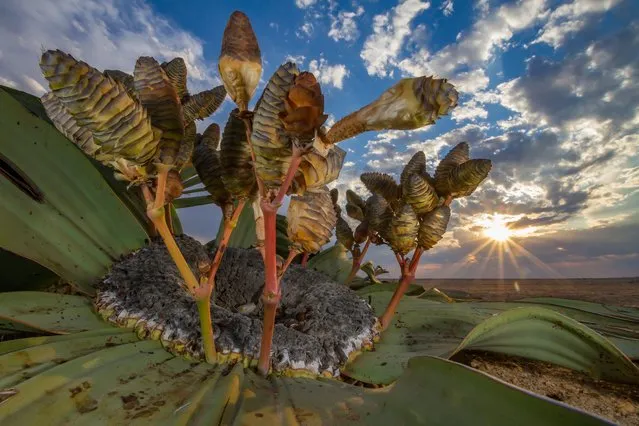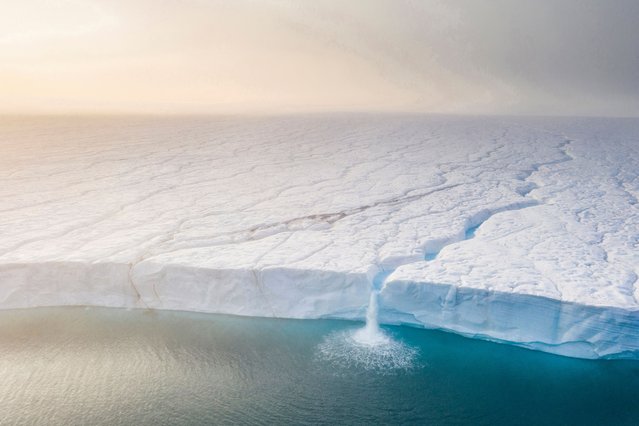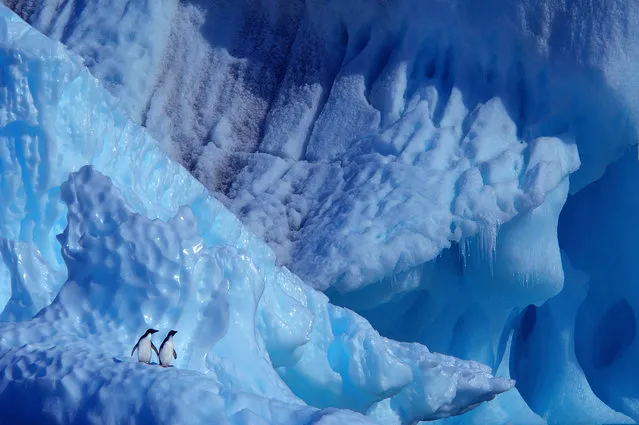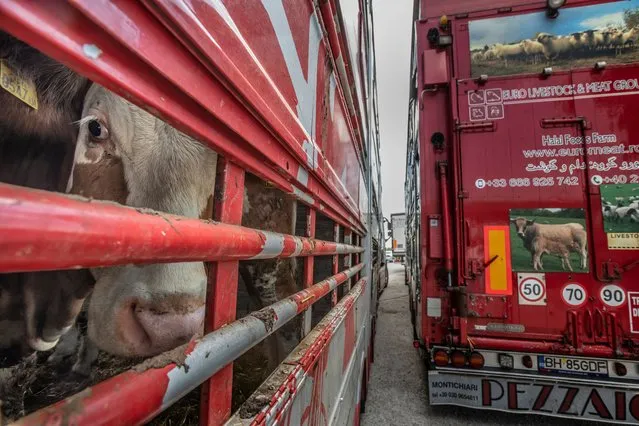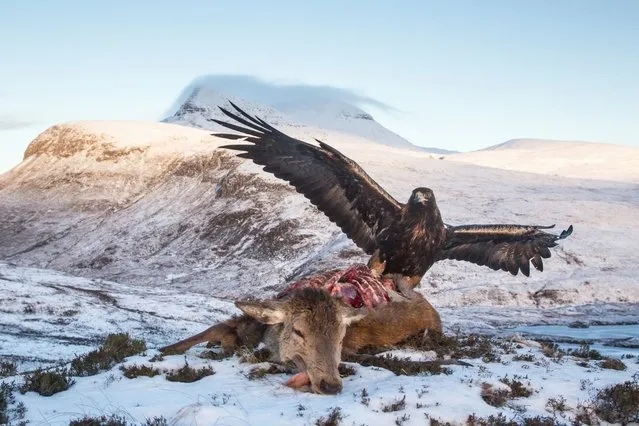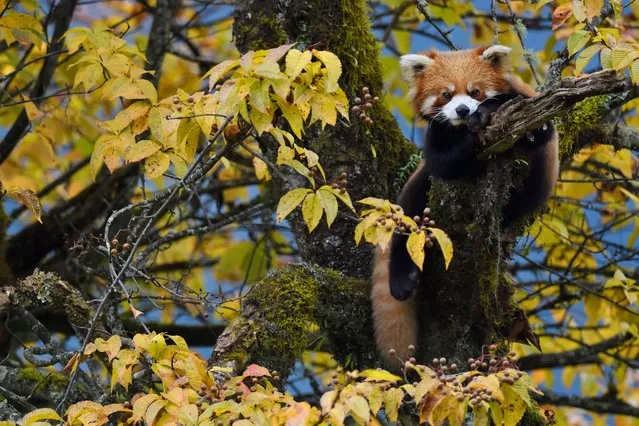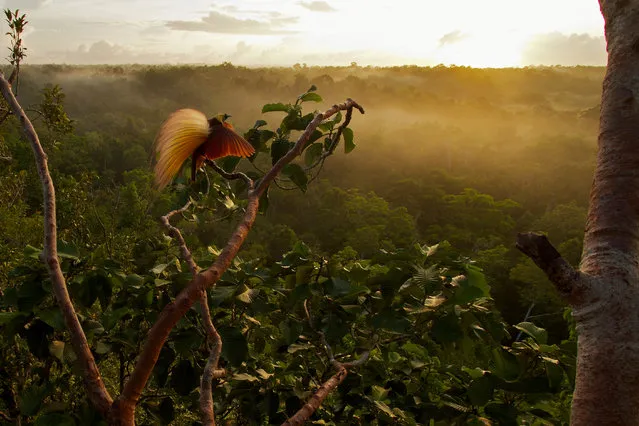
Little blue penguins standing on rocks at night, silhouetted against Melbourne city lights (St Kilda breakwater, Victoria, Australia). (Photo by Doug Gimesy/naturepl.com/LDY Agency)
Gallery 1: winner | Rhino dehorning (South Africa). South Africa has the largest population of rhinos in the world. However, there has been a catastrophic decline in their numbers due to poaching. Desperate times call for desperate measures and dehorning is a last-ditch attempt to deter poaching. Although a traumatic experience for the rhino, dehorning is like cutting one’s fingernails and the horn will grow back. “I use my camera and images to speak for me. I sometimes fail to put things in words but with photography, I can capture the entire story or message I want to convey”. (Photo by Rivoni Mkansi/naturepl.com/LDY Agency)
Gallery 2: third place | Tahafa, a male humpback whale calf with injured pectoral fin and scarred body, with its mother (Vava’u, Tonga, Pacific Ocean). The humpback whale calf (Megaptera novaeangliae) pictured here was attacked not long after he was born. His right pectoral fin has a large rip in the middle. His dorsal fin was almost cut off, and there were large chunks of flesh missing from several areas of the young whale’s body. No one saw the actual attack, so it is not possible to say with certainty how the calf was injured. (Photo by Tony Wu/naturepl.com/LDY Agency)
Gallery 2: second place | A polar bear juvenile resting on an ice floe (Spitsbergen, Svalbard, Norway). Things are changing in the Arctic and it’s not for the better. Over the past years, we have clearly seen how the glaciers on Svalbard are retreating and ocean ice is getting thinner. The ice on the fjord, where the seals are having their pups in spring, is also disappearing faster as warm water is being pushed towards the coast. In a world where its inhabitants are dependent on snow and ice, the impact of warmer ocean and air temperatures is devastating. (Photo by Roy Mangersnes/naturepl.com/LDY Agency)
Gallery 3: winner | A piglet from a large litter looks around her crate as her mother lies immobile beside her (Italy). Sows are kept in gestation crates and then farrowing crates in industrial farms, which is the standard way of raising pigs for food. The pollution caused by industrial farming – the mass production of animals – is one of the factors that accelerates climate change. (Photo by Jo-Anne McArthur/naturepl.com/LDY Agency)
The Sermeq Kujalleq glacier, entering the Kangia Ilulissat Icefjord full of icebergs, August 2019. Sermeq Kujalleq is one of the world’s most productive glaciers and the fastest moving one in the world. Within the past 10 years, the glacier has doubled its speed and today it moves about 40 metres every 24 hours. This is because ice from a very large drainage area is concentrated in a narrow stream that follows a deep trough under the glacier. Scientists also believe that rising temperatures result in increasing amounts of meltwater under the glacier. (Photo by Michel Roggo/naturepl.com/LDY Agency)
A prickly pear cactus (Opuntia engelmanni), stressed and dying as a result of drought, in the evening light in the Tucson mountains (Saguaro national park, Arizona). Since 1990, south-west US has experienced some of the most persistent droughts on record due to increasing temperatures. Arizona is currently in its 26th year of a long-term drought. (Photo by Jack Dykinga/naturepl.com/LDY Agency)
Gallery 3: second place | An adult humpback whale (Megaptera novaeangliae) diving in the Great Bear rainforest (British Columbia, Canada). The intricate mosaic of forests, islands, fjords and mountains in these coastal regions are incredibly rich and biodiverse and support a wealth of wildlife. Pacific salmon that feed in the Bering Sea migrate back to their natal rivers in British Columbia to spawn and die. In autumn the corpses litter the river margins and adjacent forests as bears, wolves and other predators feed on the bounty. The decaying salmon fertilise the entire forest. (Photo by Nick Garbutt/naturepl.com/LDY Agency)
Schools of baitfish, including cardinalfish and silversides, mass on a coral reef, with giant barrel sponge and predatory coral grouper (Misool island, Raja Ampat, West Papua, Indonesia). Our planet is home to a tremendous diversity of species, but they are not evenly spread. Life is concentrated in certain habitats and the richest of these biodiversity hotspots is a global conservation priority. The richest reefs are in south-east Asia’s coral triangle, which covers just 1.5% of the oceans, yet supports a third of the world’s coral reefs. (Photo by Alex Mustard/naturepl.com/LDY Agency)
A rescued Chinese pangolin (Manis pentadactyla). Pangolins are threatened by poaching for their meat and scales, which are used in traditional Chinese medicine, and by heavy deforestation of their natural habitats; they are the most trafficked mammals in the world. A series of conservation efforts are under way to save the last remaining wild populations in China. Poaching and trade make it easier for unknown viruses to infect humans, from bats through intermediate hosts such as pangolins. (Photo by Dong Lei/naturepl.com/LDY Agency)
A moso bamboo canopy in Shunan Zhuhai national park (Sichuan province, China). Moso bamboo (Phyllostachys edulis) is a giant grass capable of adding up to a metre per day, making it one of the fastest-growing plants. This temperate bamboo reaches harvestable size in just five years, so as new shoots are formed annually, the fully grown culms can be harvested each year, which opens up the canopy for younger plants to reach maturity. Eucalyptus trees take 15 years before they are harvested and conifers such as pine, fir, spruce and larch about 40 years. (Photo by Heather Angel/naturepl.com/LDY Agency)
A lemon shark pup (Negaprion brevirostris) in a mangrove forest, which acts as a nursery for juveniles of this species (Eleuthera, Bahamas). Mangroves provide important habitats for a number of species globally, including lemon sharks, fish and crabs seen here in the Bahamas. They are also the best-known defence against large storm surges and sequester copious amounts of carbon. Humans are destroying them at an alarming rate. (Photo by Shane Gross/naturepl.com/LDY Agency)
Palm oil crops and deforestation in the Ecuadorian Choco forest (Esmeraldas, Ecuador). South America has the highest rate of deforestation globally, and Ecuador is ranked number two on the continent, just after Brazil. Deforestation is the largest and most serious biodiversity and conservation problem in South America. (Photo by Lucas Bustamante/naturepl.com/LDY Agency)
A male kottigehar dancing frog calling to attract a female by waving its foot (Agumbe, Western Ghats, India). This tiny frog (Micrixalus kottigeharensis) breeds during the monsoon period along small forest streams. Traditionally male frogs rely on their croaking to attract females, but here they struggle to be heard over the noise of fast-flowing water. This frog, no bigger than your thumb, climbs onto a small stone and waves its foot. Global warming will negatively impact different aspects of frogs’ lives, including their immune and breeding systems, their habitat and embryo hatching process. (Photo by Yashpal Rathore/naturepl.com/LDY Agency)
A group of female sperm whales with one defecating (Sri Lanka, Indian Ocean). The whale pictured defecating here is about 12m in length. She is an adult female sperm whale (Physeter macrocephalus) swimming along with several other members of her social unit. Consider the whale’s size, and you can imagine how substantial that plume is. Whale poo is loaded with nutrients that are otherwise scarce at the ocean surface. As the whale dives and eats, surfaces and poops, she cycles nutrients from the depths of the oceans to the surface of the sea, fertilising the ocean. (Photo by Tony Wu/naturepl.com/LDY Agency)
Drying peat turves, mechanically extracted on an industrial scale, on Goldenstedt moor, near Vechta (Lower Saxony, Germany). Peat has been extracted here on an industrial scale for more than a century, but the practice is now declining as few peat moors are left and cutting is now only allowed on former farmland. Peat bogs cover just 3% of the Earth’s surface, but hold about 25% of all the carbon stored in soils, twice as much as all the forests in the world combined, so how they are conserved or exploited is an increasingly hot topic. (Photo by Nick Upton/naturepl.com/LDY Agency)
Cones of a female welwitschia plant (Welwitschia mirabilis) near Swakopmund (Namib Desert, Namibia). The cones of a female welwitschia plant extrude like a firework at sunset in the Namib desert near Swakopmund. Welwitschia are among the weirdest and most interesting plants alive today. Endemic to the Kaokoveld desert of Namibia and Angola, they are among the most ancient organisms on the planet: some individuals might be more than 2,000 years old. (Photo by Jen Guyton/naturepl.com/LDY Agency)
Gallery 1: second place | A melting ice sheet with massive waterfalls running off it (Austfonna glacier, Norway). This glacier on Nordaustlandet island in the Svalbard archipelago is Europe’s third-largest glacier by area and volume and with a glacier wall of about 200km, it is an impressive sight. During recent decades, every month has brought new record-high temperatures in the Arctic, and the ice cap on Nordaustlandet is melting at high speed. The meltwater starts as small streams but eventually gathers in larger, almost river-like systems, that finally pour off the steep wall. (Photo by Roy Mangersnes/naturepl.com/LDY Agency)
Gallery 3: third place | Two adelie penguins (Pygoscelis adeliae) on an iceberg (Antarctica). “Years ago I made a special journey through the waters of Antarctica on board the Grigoriy Mikheev, a former Russian research ship. During one of the cruises with the rubber zodiac boats, we sailed to the opening of a bay that looked like a fairytale world: beautiful blue ice rocks everywhere. This photo – with the penguins small in the frame – clearly conveys my feelings about Antarctica: an infinitely large and magical world where you as a human being feel small and insignificant”. (Photo by Edwin Giesbers/naturepl.com/LDY Agency)
Gallery 2: third place | A cow inside a transport truck (Turkish-Bulgarian border). Every year, millions of animals are transported for slaughter across Europe through the Bulgarian-Turkish border. Animals endure long hours, often without water or food, sometimes in the cold but more often in extremes of heat as they head south. Emissions created by the mass production of animals for food contributes to climate change, as does the additional emissions created by the global transport of animals. (Photo by Jo-Anne McArthur/naturepl.com/LDY Agency)
A golden eagle (Aquila chrysaetos) feeding on a red deer carcass (Assynt, Scotland). This image has an ecological story behind it. Not so long ago, Scotland was home to a much wider range of predators, including wolf and lynx. Hunted to extinction, their demise is more than a loss of a species, it’s the loss of a valuable ecological process. Predator-prey dynamics are complex and play an essential role in healthy living systems. This deer will not only feed a top predator like a golden eagle but a whole host of scavengers, from foxes and badgers down to burying beetles and bacteria. (Photo by Peter Cairns/naturepl.com/LDY Agency)
A red panda or lesser panda (Ailurus fulgens) in the humid montane mixed forest in Labahe national nature reserve (Sichuan, China). Actually not a panda but related to raccoons and coatis, the Red panda used to live in broadleaf and mixed forests all along the Himalayas but has been hunted to local extinction in many areas. Its fur is prized for ceremonial local dress and the international fur market. In recent years numbers have recovered thanks to a wide hunting ban, reforestation programmes, increased areas for nature reserves and a government clampdown on illegal trade in wildlife species. (Photo by Staffan Widstrand/naturepl.com/LDY Agency)
A scalloped hammerhead shark (Sphyrna lewini) near the surface, off Baja peninsula (Mexico). Sharks are feared and revered. The chances of being attacked by one of these enigmatic, perfectly evolved predators is virtually nil, yet humans persecute them relentlessly. Tens of millions of sharks are killed around the world every year – to make shark-fin soup, considered a delicacy in China – and many populations have been fished to extinction. As this photo of a critically endangered scalloped hammerhead shows, sharks are beautiful animals – and without them, our ocean ecosystems would collapse. (Photo by Mark Carwardine/naturepl.com/LDY Agency)
A greater bird of paradise (Paradisaea apoda) displaying in Badigaki Forest, Wokam Island (Aru Islands, Indonesia). Found here in Aru and on adjacent New Guinea, the greater bird of paradise represents about 40 different species of birds of paradise that depend on intact rainforest across the New Guinea region spanning eastern Indonesia and Papua New Guinea. With more than 80% of forest cover still intact, this region represents the largest remaining block of rainforest in the entire Asia-Pacific. (Photo by Tim Laman/naturepl.com/LDY Agency)

